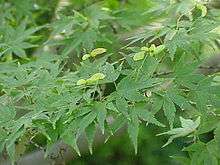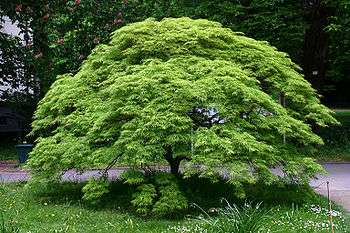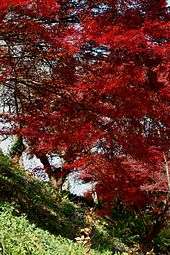Acer palmatum
| Japanese maple | |
|---|---|
 | |
| Japanese maple foliage | |
| Scientific classification | |
| Kingdom: | Plantae |
| Division: | Angiosperms |
| Class: | Eudicots |
| Order: | Sapindales |
| Family: | Sapindaceae[1] |
| Genus: | Acer |
| Species: | A. palmatum |
| Binomial name | |
| Acer palmatum Thunb. 1784 not Raf. 1836 | |
| Synonyms[2] | |
|
List
| |
Acer palmatum, called Japanese maple[3] or smooth Japanese-maple[4] (Japanese: irohamomiji, イロハモミジ, or momiji, 紅葉), is a species of woody plant native to Japan, China, Korea, eastern Mongolia, and southeast Russia.[5] Many different cultivars of this maple have been selected and they are grown worldwide for their large variety of attractive forms, leaf shapes, and spectacular colors.[6]
Description
Acer palmatum is a deciduous shrub or small tree reaching heights of 6 to 10 m (20 to 33 ft), rarely 16 metres (52 ft), often growing as an understory plant in shady woodlands. It may have multiple trunks joining close to the ground. In habit, it is often shaped like a hemisphere (especially when younger) or takes on a dome-like form, especially when mature.[7] The leaves are 4–12 cm long and wide, palmately lobed with five, seven, or nine acutely pointed lobes. The flowers are produced in small cymes, the individual flowers with five red or purple sepals and five whitish petals. The fruit is a pair of winged samaras, each samara 2–3 cm long with a 6–8 mm seed. The seeds of Japanese maple and similar species require stratification in order to germinate.[7][8]
Even in nature, Acer palmatum displays considerable genetic variation, with seedlings from the same parent tree typically showing differences in such traits as leaf size, shape, and color. Overall form of the tree can vary from upright to weeping.[7]
Three subspecies are recognised:[7][8]
- Acer palmatum subsp. palmatum. Leaves small, 4–7 cm wide, with five or seven lobes and double-serrate margins; seed wings 10–15 mm. Lower altitudes throughout central and southern Japan (not Hokkaido).
- Acer palmatum subsp. amoenum (Carrière) H.Hara. Leaves larger, 6–12 cm wide, with seven or nine lobes and single-serrate margins; seed wings 20–25 mm. Higher altitudes throughout Japan and South Korea.
- Acer palmatum subsp. matsumurae Koidz. Leaves larger, 6–12 cm wide, with seven (rarely five or nine) lobes and double-serrate margins; seed wings 15–25 mm. Higher altitudes throughout Japan.
Cultivation and uses

Japanese maple has been cultivated in Japan for centuries and in temperate areas around the world since the 1800s.[7] The first specimen of the tree reached England in 1820.
When Swedish doctor-botanist Carl Peter Thunberg traveled in Japan late in the eighteenth century, he secreted out drawings of a small tree that would eventually become synonymous with the high art of oriental gardens.[9] He gave it the species name palmatum after the hand-like shape of its leaves, similar to the centuries-old Japanese names kaede and momiji, references to the 'hands' of frogs[10] and babies, respectively.
For centuries Japanese horticulturalists have developed cultivars from maples found in Japan and nearby Korea and China. They are a popular choice for bonsai[11] enthusiasts and have long been a subject in art.
Numerous cultivars are currently available commercially and are a popular item at garden centres and other retail stores in Europe and North America. Red-leafed cultivars are the most popular, followed by cascading green shrubs with deeply dissected leaves.[7]
Preparations from the branches and leaves are used as a treatment in traditional Chinese medicine.[12]
Growing conditions

Acer palmatum includes hundreds of named cultivars with a variety forms, colors, leaf types, sizes, and preferred growing conditions. Heights of mature specimens range from 0.5 m to 25 m, depending on type. Some tolerate sun, but most prefer part shade, especially in hotter climates. Almost all are adaptable and blend well with companion plants. The trees are particularly suitable for borders and ornamental paths because the root systems are compact and not invasive. Many varieties of Acer palmatum are successfully grown in containers.[13] Trees are prone to die during periods of drought and prefer consistent water conditions; more established trees are less prone to drought. Trees should be mulched with a thick layer of bark. Well-drained soil is essential as they will not survive in soggy waterlogged soil. Trees do not require or appreciate heavy fertilization and should only be lightly fertilized, preferably using slow-release fertilizer with a 3 to 1 ratio of nitrogen to phosphorus respectively. Nitrogen lawn fertilizer should be avoided in the immediate vicinity of these trees as excessive nitrogen can cause overly vigorous growth that is prone to pathogens.
Pruning
If space is not a constraint, no pruning is necessary except to remove any dead branches. Trees naturally self-prune foliage that doesn't receive enough light, such as internal branches which are overly shaded by its own canopy. Some growers prefer to shape their trees artistically or to thin out interior branches to better expose the graceful main branches. The form of the tree, especially without leaves in winter, can be of great interest and can be pruned to highlight this feature. Trees heal readily after pruning without needing aftercare. This species should not be pruned like a hedge, but instead methodically shaped by carefully choosing individual branches to remove. They can also be pruned just to maintain a smaller size to suit a particular location. Japanese maples can also be used as espalier.
Cultivars
Over 1,000 cultivars have been chosen for particular characteristics, which are propagated by asexual reproduction most often by grafting, but some cultivars can also be propagated by budding, cuttings, tissue culture, or layering. Some cultivars are not in cultivation in the Western world or have been lost over the generations, but many new cultivars are developed each decade.[7] Cultivars are chosen for phenotypical aspects such as leaf shape and size (shallowly to deeply lobed, some also palmately compound), leaf color (ranging from chartreuse through dark green or from red to dark purple, others variegated with various patterns of white and pink), bark texture and color, and growth pattern. Most cultivars are less vigorous and smaller than is typical for the species, but are more interesting than the relatively mundane species. Cultivars come in a large variety of forms including upright, broom, weeping, cascading, dwarf, and shrub. Most cultivars are artificially selected from seedlings of open-pollinated plants, purposeful breeding is not common, and less often from grafts of witch's brooms.

In Japan, iromomiji is used as an accent tree in Japanese gardens, providing gentle shade next to the house in the summer and beautiful colors in autumn. Many cultivars have characteristics that come into prominence during different seasons, including the color of new or mature leaves, extraordinary autumn color, color and shape of samaras, or even bark that becomes more brightly colored during the winter. Some cultivars can scarcely be distinguished from others unless labeled. In some cases, identical cultivars go by different names, while in other cases, different cultivars may be given the same name.
Example cultivars
A selection of notable or popular cultivars, with brief notes about characteristics that apply during at least one season, includes the following.[7] agm indicates the cultivar has gained the Royal Horticultural Society's Award of Garden Merit.
- 'Aka shigitatsu sawa'; pinkish-white leaves with green veins
- 'Ao ba jo'; a dwarf with bronze-green summer foliage
- Atropurpureum; wine-red, including new branches
- 'Bloodgood'agm;[14] an improved cultivar of 'Atropurpureum'
- 'Burgundy Lace'agm[15]
- 'Butterfly'; small leaves with white borders
- 'Chitose-Yama'agm[16]
- 'Crimson Queen' (see under 'Dissectum')
- 'Dissectum'; lace-like leaves, drooping habit
- 'Dissectum Atropurpureum'
- var. dissectum 'Garnet'agm[17]
- var. dissectum 'Inaba-shidare'agm[18]
- var. dissectum 'Crimson Queen'agm[19]
- var. dissectum 'Seiryu';agm[20] a green, tree-like shrub with finely dissected leaves
- 'Emperor 1'
- 'Garnet' (see under 'Dissectum atropurpureum')
- 'Golden Pond'; greenish-yellow summer foliage
- 'Goshiki koto hime'; a delicate, variegated dwarf
- 'Higasa yama'; crinkled leaves variegated with yellow
- 'Hogyuko'; rich green leaves, turning orange in autumn
- 'Hupp's Dwarf'; a small, dense shrub with miniature leaves
- 'Inaba-shidare' (see under 'Dissectum atropurpureum')
- 'Issai nishiki kawazu'; very rough, rigid bark
- 'Kagiri nishiki'; similar to 'Butterfly' but more pinkish tones
- 'Karasu gawa'; slow-growing variegate with brilliant pink and white
- 'Katsura'agm;[21] yellow-green leaves tipped with orange
- 'Koto no ito'; light green, thread-like leaves
- 'Little Princess'; a sparsely branched dwarf with irregular habit
- 'Mama'; a bushy dwarf with extremely variable foliage
- 'Masu murasaki'; a shrubby tree with purple leaves
- 'Mizu kuguri'; orange-tinted new growth and very wide habit
- 'Nigrum';agm[22] deep purple leaves turning to crimson
- 'Nishiki gawa'; pinetree-like bark desirable for bonsai
- 'Nomura nishiki'; dark purple, lace-like leaves
- 'Ojishi'; tiny dwarf, grows only a few centimetres per year
- 'Osakazuki';agm[23] tree-like shrub with spectacular autumn color
- 'Peaches and Cream'; similar to 'Aka shigitatsu sawa'
- 'Pink Filigree'; finely dissected, brownish-pink leaves
- 'Red Filigree Lace'; delicate, finely dissected, dark purple
- 'Red Pygmy'agm[24]
- 'Sango kaku';agm[25] Coral-bark maple (formerly 'Senkaki'); with pinkish-red bark (AGM)[]
- 'Seiryu' (see under 'Dissectum atropurpureum')
- 'Shaina'; a dwarf sport from 'Bloodgood'
- 'Shindeshojo'
- 'Shikage ori nishiki'; vase-shaped shrub with dull purple foliage
- 'Shishigashira'
- 'Skeeter's Broom'; derived from a 'Bloodgood' witch's broom
- 'Tamukeyama'; finely dissected, dark purple, cascading habit
- 'Trompenburg';agm[26] slender, upright grower, convex lobes, purple leaves (AGM)[]
- 'Tsuma gaki'; yellow leaves with reddish-purple borders
- 'Yuba e'; upright tree with scarlet variegation

In addition to the cultivars described above, a number of cultivar groups have been naturally selected over time to such an extent that seedlings often resemble the parent. Many of these are sold under the same name as the cultivars, or even propagated by grafting, so there is often much ambiguity in distinguishing them.[7] In particular, a number of dark-red Japanese maples are sold with the names "Atropurpureum" and "Bloodgood." Many different cultivars with delicate lace-like foliage are sold under names such as "Dissectum", "Filigree" and "Laceleaf.".[7]
Similar species
The term "Japanese maple" is also sometimes used to describe other species usually within series Palmata that are similar to A. palmatum and are native to China, Korea or Japan including:
- Acer duplicatoserratum (syn. A. palmatum var. pubescens Li)
- Acer japonicum—Downy Japanese maple
- Acer pseudosieboldianum—Korean maple
- Acer shirasawanum—Fullmoon maple
- Acer sieboldianum—Siebold's maple
- Acer buergerianum—Trident maple
Given that these maples are phenotypically variable within each species, and may hybridise with one another, distinguishing between them may be a matter of gradient speciation. In commercial propagation, A. palmatum is often used as rootstock for many of these other species.[7]
References
- ↑ Stevens, P. F. (2001 onwards). Angiosperm Phylogeny Website. Version 9, June 2008 [and more or less continuously updated since]. http://www.mobot.org/MOBOT/research/APweb/.
- ↑ The Plant List, Acer palmatum Thunb.
- ↑ "Acer palmatum". Natural Resources Conservation Service PLANTS Database. USDA. Retrieved 6 January 2016.
- ↑ "BSBI List 2007" (xls). Botanical Society of Britain and Ireland. Archived from the original on 2015-02-25. Retrieved 2014-10-17.
- ↑ Germplasm Resources Information Network: Acer palmatum
- ↑ Philips, Roger (1979). Trees of North America and Europe. New York: Random House. ISBN 0-394-50259-0.
- 1 2 3 4 5 6 7 8 9 10 11 van Gelderen, C.J. & van Gelderen, D.M. (1999). Maples for Gardens: A Colour Encyclopedia.
- 1 2 Rushforth, K. (1999). Trees of Britain and Europe. Collins ISBN 0-00-220013-9.
- ↑ Japanese Red Maple - arborday.org Archived April 25, 2010, at the Wayback Machine.
- ↑ (Japanese) Etymology of 楓. The word kaede derives from kaeru te "frog hand" and went through the intermediary form kaende.
- ↑ D'Cruz, Mark. "Acer palmatum Bonsai Care Guide". Ma-Ke Bonsai. Retrieved 2010-11-26.
- ↑ School of Chinese Medicine database Archived March 3, 2016, at the Wayback Machine.
- ↑ Vertrees, J.D. (1987) Japanese Maples. Timber Press, Inc. ISBN 0-88192-048-7
- ↑ "RHS Plant Selector - Acer palmatum 'Bloodgood'".
- ↑ "RHS Plant Selector - Acer palmatum 'Burgundy Lace'". Retrieved 10 June 2013.
- ↑ "RHS Plant Selector - Acer palmatum 'Chitose-Yama'". Retrieved 10 June 2013.
- ↑ "RHS Plant Selector - Acer palmatum var. dissectum 'Garnet'". Retrieved 10 June 2013.
- ↑ "RHS Plant Selector - Acer palmatum var. dissectum 'Inaba-shidare'". Retrieved 10 June 2013.
- ↑ "RHS Plant Selector - Acer palmatum var. dissectum 'Crimson Queen'". Retrieved 10 June 2013.
- ↑ "RHS Plant Selector - Acer palmatum 'Seiryu'". Retrieved 10 June 2013.
- ↑ "RHS Plant Selector - Acer palmatum 'Katsura'". Retrieved 10 June 2013.
- ↑ "RHS Plant Selector - Acer palmatum 'Nigrum'". Retrieved 10 June 2013.
- ↑ "RHS Plant Selector - Acer palmatum 'Osakazuki'". Retrieved 10 June 2013.
- ↑ "RHS Plant Selector - Acer palmatum 'Red Pygmy'". Retrieved 10 June 2013.
- ↑ "RHS Plant Selector - Acer palmatum 'Sango-kaku'". Retrieved 10 June 2013.
- ↑ "RHS Plant Selector - Acer palmatum 'Trompenburg'". Retrieved 10 June 2013.
External links
| Wikimedia Commons has media related to Acer palmatum. |
| Wikispecies has information related to: Acer palmatum |
- RHS: Acer palmatum cultivation
- photo of herbarium specimen at Missouri Botanical Garden, collected in Japan
- Shoot: Acer palmatum 'Orange Dream'